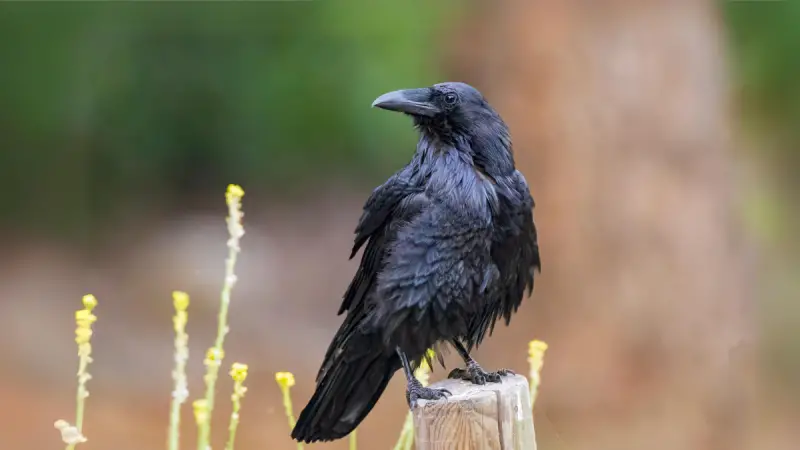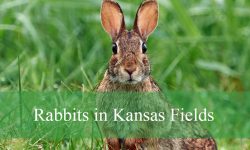High above the glaciers and spruce forests of Alaska, a black shape cuts through the cold air. Its wings flash glossy blue in the sunlight, its deep croak echoes against the mountains, and for a moment, it feels like something more than just a bird — something ancient, calculating, and aware. These are the ravens in Alaska, and they may be far smarter than you’ve ever imagined.
Long seen as tricksters in Native legends and companions to wolves in the wild, ravens are among the most intelligent birds on Earth. In Alaska’s rugged landscapes — where survival demands wit as much as strength — they have evolved into masters of adaptation, communication, and problem-solving.
This article reveals why the common raven (Corvus corax), Alaska’s largest songbird, deserves its reputation as the genius of the north — exploring its intelligence, behavior, social life, and uncanny relationship with both humans and nature.
Meet Alaska’s Raven

The Common Raven
Alaska is home almost entirely to the common raven, a species that thrives from coastal tundra to boreal forest. Measuring up to 27 inches long with a wingspan nearing four feet, this striking bird is both majestic and formidable.
Ravens are instantly recognizable by their thick black beaks, shaggy throat feathers, and powerful voices that range from croaks and clicks to surprisingly musical tones. They weigh about three pounds — hefty for a songbird — and can live up to 20 years in the wild, even longer in captivity.
Unlike their cousins, crows, ravens in Alaska prefer solitude or small family groups over large flocks. They are built for endurance, capable of soaring thousands of feet above mountain ridges and gliding effortlessly across the tundra winds.
Ravens and the Alaska Wilderness
Few creatures are as perfectly suited to Alaska’s extremes as the raven. From the coastal fjords of Kenai to the windswept tundra of Nome, they endure temperatures below -40°F, scavenging and hunting year-round.
Their omnivorous diet includes carrion, berries, fish scraps, insects, and even garbage near human settlements. This flexibility has allowed them to colonize every region of the state — from remote wilderness to Anchorage parking lots.
Wherever life exists in Alaska, the raven is never far away — watching, waiting, and adapting with uncanny intelligence.
The Intelligence of Ravens
Problem Solvers of the Arctic
Ravens are renowned for their ability to solve puzzles, use tools, and think several steps ahead. In laboratory studies, they’ve outperformed most birds — and even some primates — in tasks involving logic, planning, and memory.
In Alaska’s natural laboratories — the icy wilderness — they display the same intelligence daily. They drop nuts onto roads for cars to crack open, pull fish out of ice holes left by anglers, and use snowbanks to hide food from competitors.
Researchers have observed ravens in Alaska unzipping tents, flipping latches on trash bins, and stealing bait from ice-fishing lines — behaviors showing insight, not instinct. They understand cause and effect and often manipulate situations to their advantage.
Memory and Foresight
Ravens remember individual faces and voices — both human and animal. In long-term studies, they recognized people who had fed or threatened them even after several years.
In the wild, they cache food in dozens of hidden spots and recall the exact locations weeks later. Some even re-hide their food if they sense another raven watching, demonstrating not just memory but a theory of mind — the ability to imagine what another being knows.
In the harsh Alaskan winters, that kind of foresight can mean the difference between life and death.
Communication Mastery
Ravens are not just mimics; they are linguists of the sky. They produce more than 100 distinct sounds, from soft gurgles to metallic knocks, each serving a purpose — warnings, invitations, greetings, or playful banter.
Alaskans often hear their voices echoing through valleys or over frozen rivers — an eerie reminder of their presence. Some mimic wolves or even human speech. In the wild, ravens use vocal signals to coordinate group activities, call out threats, and even play tricks on other animals.
Their complex communication is part of what makes them social thinkers — a hallmark of advanced intelligence.
Ravens and Wolves: An Ancient Partnership
A Mutual Understanding
One of the most fascinating relationships in Alaska’s wilderness is between ravens and wolves. The two species often hunt and scavenge together, forming an unlikely alliance based on shared benefit.
When wolves make a kill, ravens are often the first to arrive. They circle overhead, calling loudly — not just to feed, but to summon the wolves. Wolves tear open carcasses that ravens cannot breach on their own, while ravens, with their sharp eyes, help locate prey.
Scientists believe this collaboration evolved over thousands of years. Observers have even reported ravens teasing wolf pups or flying ahead of hunting packs as guides — behavior that suggests familiarity and playfulness rather than fear.
Beyond Food
The raven-wolf connection runs deeper than survival. Both species are territorial, intelligent, and highly social. They share communication patterns — complex vocalizations, cooperation, and even mourning rituals.
In many Indigenous Alaskan traditions, the raven is seen as a messenger or companion to the wolf — a reflection of their real-world bond. Together, they embody balance in the wild: cunning intellect paired with raw strength.
Social Behavior and Emotional Depth
Family Bonds
Though often seen alone, ravens in Alaska form strong pair bonds that can last for life. Mated pairs build large stick nests high in cliffs, trees, or even power poles, returning to them year after year.
During nesting season, both parents care for their young, feeding them regurgitated food and teaching them to fly. Juvenile ravens stay with their parents for months, learning the complex social and survival skills that define their species.
Their family dynamics — loyalty, shared care, and long-term memory — echo the intelligence seen in dolphins, elephants, and primates.
Playfulness and Emotion
Ravens are famous for their play. In Alaska’s winter skies, you can watch them performing aerial acrobatics — rolling, diving, or sliding down snowy rooftops purely for fun. They’ve been seen playing tug-of-war with sticks, making snowballs, and even teasing dogs or eagles.
Play requires imagination, energy, and awareness — traits once thought exclusive to humans. Their curiosity drives them to explore objects, test reactions, and sometimes just enjoy the joy of movement.
It’s no exaggeration to say ravens in Alaska display emotional intelligence — curiosity, affection, and even empathy.
Diet and Survival Strategies
Omnivorous Opportunists
Ravens eat almost anything. In the frozen north, where food is scarce, this omnivory ensures their survival. They feed on carrion, small mammals, berries, fish remains, insects, and eggs.
Near coastal towns and fishing villages, they scavenge docks and dumpsters, pulling trash apart with surprising dexterity. Inland, they trail hunters and predators, ready to feast on leftovers.
Unlike scavengers who depend solely on luck, ravens create opportunities. They mimic predator calls to scare smaller birds from food, or they cache surplus meat in snowbanks to retrieve later.
Winter Adaptations
In Alaska’s harsh winters, when temperatures drop below zero and daylight fades, ravens remain active while many animals hibernate or migrate. Their thick plumage and ability to puff up feathers for insulation help conserve heat.
They form small roosting groups at night, sharing body warmth and shelter. In cities like Fairbanks or Anchorage, you can see dozens perched on light poles, absorbing heat from human infrastructure — evidence of their adaptability.
Through intelligence and flexibility, ravens in Alaska have conquered environments few animals can endure year-round.
Ravens and Humans in Alaska
Urban Tricksters
From Anchorage to Juneau, ravens are part of daily life. They watch parking lots for unattended groceries, unzip backpacks left on snow, and steal shiny trinkets from outdoor markets.
Locals tell endless stories of raven mischief — stealing dog food from sled teams, opening trash bins, or mimicking car alarms. These antics are not random; they show problem-solving, patience, and memory.
Some Alaskans consider them pests, while others admire their cleverness. In truth, ravens have simply learned to read human behavior and exploit our habits — a hallmark of adaptive intelligence.
In Alaskan Culture and Legend
For Alaska’s Indigenous peoples, especially the Tlingit, Haida, and Inuit, the raven holds sacred importance. He is the creator, the trickster, and the bringer of light — a figure who bridges the gap between the natural and spiritual worlds.
These stories reflect centuries of observation: the raven’s curiosity, boldness, and intelligence. To the people who have shared the land with them for millennia, ravens are not mere birds but beings of power, wisdom, and humor.
Even today, ravens appear in Alaskan art, carvings, and storytelling — reminders of the deep bond between nature and culture.
Ravens as Engineers of Ecosystems
Nature’s Cleanup Crew
As scavengers, ravens in Alaska play an essential ecological role. By feeding on carrion, they prevent the spread of disease and recycle nutrients back into the environment.
Their presence around wolf kills, moose carcasses, and fisheries helps maintain balance in complex ecosystems. In coastal regions, ravens feed on dead fish and marine debris, linking ocean and land food webs.
Every meal they take, every scrap they move, contributes to Alaska’s natural cycles of renewal and decay.
Seed Spreaders and Soil Builders
Though known for scavenging, ravens also eat berries and fruits, dispersing seeds across wide territories through droppings. This helps regenerate vegetation in areas disturbed by fires or thawing permafrost.
Their habit of caching food — burying berries or meat — adds organic material to the soil, supporting plant growth and microbial activity. In ways both small and profound, they are gardeners of the north.
Science and Surprising Studies
The Raven’s Mind
Neuroscientists have found that ravens’ brains, though small, are proportionally as complex as primates’. Their forebrain — the region linked to planning and reasoning — shows remarkable neuron density.
In experiments, ravens used tools, planned for future rewards, and even delayed gratification — choosing better food later over quick snacks. Such cognitive control is rare in animals.
In Alaska, similar behaviors play out naturally: storing food for months, coordinating hunts with wolves, and remembering which humans to trust. These are signs of foresight and judgment — intelligence rooted in survival.
Imitation and Cultural Learning
One reason ravens in Alaska seem so clever is their ability to learn socially. They observe and imitate other ravens, wolves, and even people. When one bird discovers a new food source or trick — like opening containers — others copy it.
This cultural transmission spreads quickly, forming local “traditions.” A raven in Anchorage may learn to unzip zippers, while one in the Arctic learns to follow sled dogs. Each population evolves its own set of survival strategies, shared across generations.
That’s not instinct — that’s culture.
Climate Change and the Future of Alaska’s Ravens
Expanding Range
As Alaska warms, ravens are extending their range northward into the Arctic tundra. Milder winters and human expansion provide more food and nesting opportunities.
While this demonstrates their resilience, it also creates challenges. Ravens can outcompete native scavengers like gulls and foxes, and their presence near nesting seabirds sometimes leads to predation.
Conservationists now study how changing climates alter this balance — and how ravens in Alaska will adapt to a rapidly evolving landscape.
Coexistence With Humans
Human-raven conflicts are minimal compared to other species. Most Alaskans view them with a mix of respect and amusement. Some communities even feed ravens during severe winters, maintaining bonds that date back to early settlements.
Education and waste management help reduce negative encounters, ensuring that ravens remain wild yet integrated members of Alaska’s ecosystems — partners, not pests.
Surprising and Little-Known Facts About Ravens in Alaska
-
Ravens can mimic over 100 sounds, including human words and animal calls.
-
They’ve been observed playing “games” with dogs, foxes, and each other.
-
Ravens can recognize themselves in mirrors — a sign of self-awareness.
-
Their feathers are iridescent, reflecting blue and violet under sunlight.
-
Pairs mate for life and perform synchronized flight displays during bonding.
-
Ravens cache food under snow and ice to preserve it through winter.
-
They use tools — such as sticks — to access hard-to-reach food.
-
Their calls vary regionally, forming local “dialects.”
-
Ravens have funerals, gathering quietly around deceased individuals.
-
They’ve been Alaska’s official state bird since 1959 — the year it became a state.
FAQs About Ravens in Alaska
How many raven species live in Alaska?
Only one — the common raven (Corvus corax), widespread across the state.
Are ravens smarter than crows?
Yes, slightly. Ravens show greater problem-solving ability and more complex social behavior.
Do ravens migrate in winter?
No. They stay year-round, adapting perfectly to Alaska’s harsh climate.
What do ravens eat in Alaska?
Carrion, berries, fish scraps, insects, small mammals, and human leftovers.
Do ravens talk like parrots?
They can mimic human speech, though usually only in captivity or around humans they trust.
Are ravens protected in Alaska?
Yes. They’re protected under the Migratory Bird Treaty Act, which prohibits harm without permits.
How long do ravens live?
In the wild, around 15–20 years. In captivity, some exceed 40.
Are ravens dangerous?
No. They’re cautious and rarely threaten humans — though they may defend nests or steal food.
Why are ravens important to the ecosystem?
They clean carrion, disperse seeds, and maintain food web balance.
What’s the best place to see ravens in Alaska?
Everywhere — from Denali to Anchorage, they’re among the state’s most visible and iconic birds.
Final Thoughts
The ravens of Alaska are not just birds — they are thinkers, communicators, and survivors who embody the intelligence of nature itself. Their adaptability rivals any mammal’s, their problem-solving surpasses expectation, and their relationship with humans and wilderness alike is centuries deep.
In the frozen silence of the Alaskan tundra, the raven’s croak is more than a sound — it’s a declaration of life, wit, and resilience. They remind us that intelligence comes in many forms and that wisdom often hides behind dark feathers and clever eyes.
The truth is simple: ravens in Alaska aren’t just smarter than we think — they’re reminders of the mind alive within the wild, watching us as much as we watch them.






